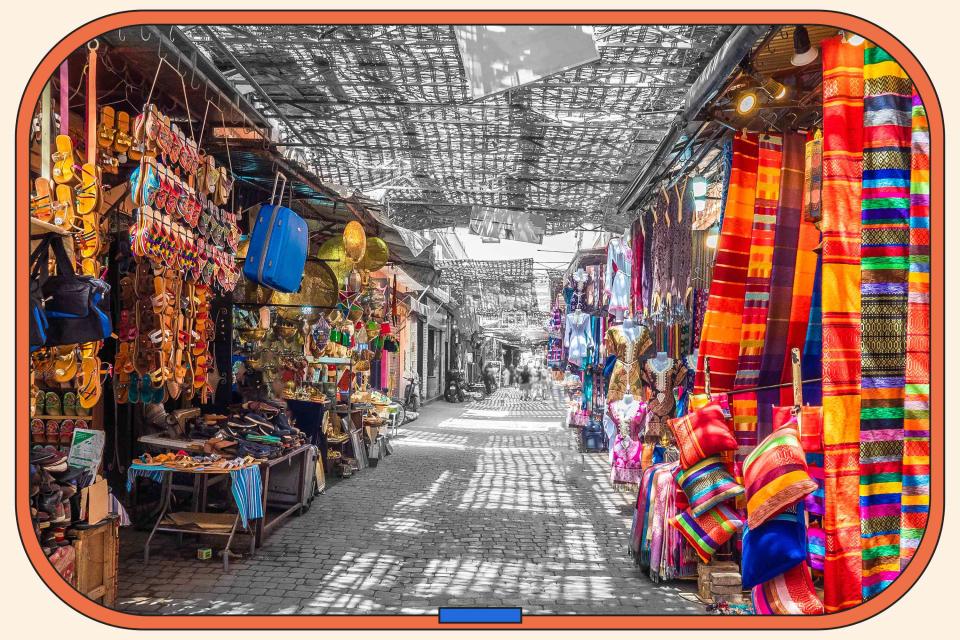Spice Shops Tell a Deeper Story About Moroccan History
For nearly 1,000 years, Marrakech has been a hub for the world’s spice trade.

Getty
Nearly every major spice brand has its interpretation of Moroccan spice mix. While these products do a decent job at simulating the flavors of Moroccan cuisine, nothing compares to the true deal that can only be found among spice shops nestled deep within the souks of Morocco.
No city represents Moroccan authenticity quite like Marrakech, thanks to its cultural importance and preservation of history. This city contains dozens of spice shops scattered all around its labyrinth-like streets. These shops, unique to one another, invite you in by stimulating all your senses. Your nose will widen from the wafting turmeric and harissa and your eyes will glue to the multicolored cone-shaped piles of spices miraculously held together, while your ears focus on the cacophony of shopkeepers hollering their deals and wares; visiting a spice shop in Marrakech is a sensory paradise unlike anywhere else in the world.
Related: There’s Never Been a Better Time to Visit Marrakech
Since the 11th century, tradespeople have descended upon the city’s main square, the Jemaa el-Fna, to sell their goods to locals and visitors alike. Spices in particular have long been a draw for the area as the country was a stop on the spice trade route between Europe, the Middle East, and Asia. Now, the region is known for its own spices and blends, most notably, ras el hanout. The North African spice blend is a staple in Moroccan cooking and consists of six to 20 different spices which vary between shops. Cumin, nutmeg, cardamom, cinnamon, ginger, and cayenne pepper are most commonly used, however, rosemary, oregano, saffron powder, nigella, sumac, garlic powder, and turmeric are often added, depending on each store’s unique blend.
As its name in Moroccan Darija — the country’s regional dialect of Arabic — implies, ras el hanout, or ‘the head of the shop,’ is the magnum opus of every spice shop with the recipe passed down through generations. Many shops in the areas of Fhal Zefriti or Mellah, and the souks in Rahba Kedima, have been around for decades, developing a devoted clientele for their spice offerings and unique spice combinations.
Related: This Gorgeous Hotel in Marrakech Wants to Teach You How to Cook During Your Vacation in Morocco
In Mellah, visitors can shop for meat and produce or explore the winding streets that once housed the city’s Jewish community. There are also plenty of European-style cafés and upscale restaurants that make the area prime for spending a few hours. And Fhal Zefriti, a winding street filled with shops and dotted with dozens of hotels, is only a quick walk from the Jemaa el-Fna.
But spices are not the only tool in a Moroccan cook’s arsenal to bring in flavor. Often sold by the same spice shops, pickled and marinated goods equally unlock deeper taste profiles of a dish. Within the stalls that pile mountains of spices, you’ll find artfully arranged stacks of pickled lemons, peppers, or whatever vegetable the shopkeeper deems fit to pickle. But the true star of the show is the olives, mixing both Mediterranean and Middle Eastern cuisine, which is an ode to Morocco’s history, marinated and pickled olives of various colors.
So even if you don’t consider yourself a cook, a walk through the city’s many markets is a must. Whether you’re picking up something special for friends or family, or just soaking in the sights and sounds of the souks, Marrakech is a culinary experience to remember.
For more Food & Wine news, make sure to sign up for our newsletter!
Read the original article on Food & Wine.

 Yahoo News
Yahoo News 
